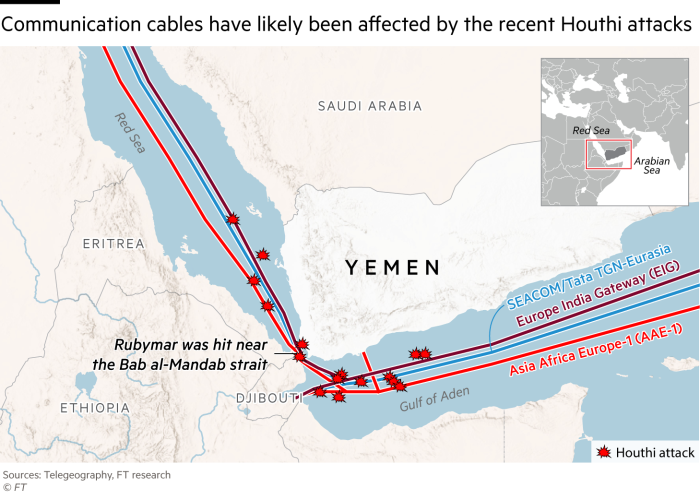
Telecom and tech groups are being forced to reroute internet traffic after attacks in the Red Sea have made the area increasingly unstable, with damage to undersea cables putting connectivity and services around the world at risk.
Multiple companies said they had taken action after reports that submarine cables in the seabed had been cut by an anchor from the Rubymar ship, which was abandoned in February after it was targeted and sunk by Houthi rebels.
Tech giant Microsoft said this week that “ongoing cable cuts” in the Red Sea were affecting overall capacity on the east coast of Africa and that it was redirecting traffic flows as a result.
The Red Sea is a key route for sending internet traffic between the Middle East, Africa, Asia and Europe via undersea cables, which transport 99 per cent of intercontinental data. TeleGeography, a consultancy, estimates that more than $10tn-worth of financial transactions are transmitted via these cables every day.
Houthi targeting of commercial ships in the region, which the group says is in support of Palestinians amid the Israel-Hamas war in Gaza, has recently escalated. The Iran-backed group claimed its first fatalities in a strike in early March.
The US has said that an anchor dragging from the Rubymar as it sank was responsible for recent cuts to undersea cables in the Red Sea that disrupted global traffic.
Hong-Kong based HGC Global Communications, which provides global coverage, estimated that 25 per cent of traffic had been affected after multiple submarine cables were cut and said it had taken measures to reroute affected traffic.
Seacom, which owns a number of subsea cables, said it also rerouted services last month, acknowledging some clients had experienced “an impact on their businesses across east and southern Africa”.
The company said last week it was “optimistic” cable repairs would take place during the second quarter but that it was “mindful of the ongoing unrest in the region”, which it said might introduce unforeseen challenges.
Other leading telecoms companies have downplayed concerns over the cuts. Orange, which uses but does not own the damaged cables in the Red Sea, said it was putting additional security in place. But the French operator, along with AT&T and Tata Communications, told the Financial Times that they were able to reroute traffic in the event of problems.

Damage to cables and rerouting as a result is not uncommon, executives and analysts say, with the most common causes cited as dragging anchors and fishing trawler activity.
Alan Mauldin, research director at TeleGeography, said such factors caused faults “every three days somewhere in the world on average”.
Operators have capacity on many different cables, with the majority of countries able to withstand multiple cable outages, he said.
“If two or three more cables were to be knocked out, and if they were high capacity ones, those could have a more severe impact in connectivity for certain network operators or countries,” Mauldin added.
Keri Gilder, chief executive at digital infrastructure company Colt Technology Services, said the company has previously had to migrate data quickly from one cable to another because of damage caused by fishing boats.
“There can be an impact on quality of service in regards to latency,” Gilder added, referring to the delay in time getting data from one place to another, which could, for example, affect video calls. “For us in business it’s milliseconds.”
Colt has not had to redirect traffic in the Red Sea but Gilder said the route was “very congested” and she was not surprised cables had been cut because the pathway was relatively narrow and shallow.
The Houthis have denied deliberately targeting undersea cables, while Yemeni officials have said they are in daily contact with international submarine companies in the Red Sea and will provide support to repair any damage.
Chris van Zinnicq Bergmann, chief commercial officer at Unitirreno, a subsea partnership in Italy that is building a cable in the Mediterranean, said: “the worst-case scenario is that all cables get cut. That would be a very serious situation.”
This would result in the diversion of traffic over longer routes, hitting the quality of video traffic, financial trades and cloud applications, he added. “If a trading firm has a circuit on a cable that gets cut, for that particular firm that’s a big problem because it takes time to get an alternative connection up and running. Also, if you take a long route, that will impact the trading because you add latency to the connection.”
Marcus Solarz Hendriks, a research fellow at think-tank Policy Exchange, pointed to a 2006 earthquake that hampered international banking services and trading in Hong Kong and South Korea.
While most network operators were able to reroute traffic, the incident caused low connection speeds for internet users in Hong Kong, while Bloomberg terminals used by traders were down across the city.
“The impact would be similarly severe if a Red Sea cable incident were to disrupt digital bandwidth sufficiently,” Solarz Hendriks said.
Additional reporting by Alexandra Heal
